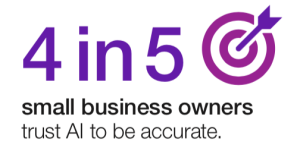Despite the fact it’s large organizations that typically get the lion’s share of attention from news outlets or politicians, the often forgotten fact is that it’s small businesses that form the backbone of the US economy.
Some 99.9% of all businesses in America (around 33.3 million in total), are small businesses, with data from the Small Business Administration revealing that this cohort employs nearly half (46%) of all employees. This is a remarkable statistic, given 80% of SMEs actually have no staff at all (they are sole enterprises) – meaning that it’s the remaining 20% that are responsible for this huge level of employment.
And yet, while small businesses are often able to sell themselves of having a more flexible, more paternalistic approach, it’s also a fact that small businesses they face just the same recruitment challenges as larger firms.
What large businesses can learn from smaller ones
To look into this in more detail, the recently published 2024 People and Programs Report by Hiscox – a leading insurer for more than 600,000 small businesses in the US – surveyed 1,000 US small business owners to explores the strategies they use to maintain work-life balance and encourage recruitment.
But we believe the results of this survey actually offer significant insights for HR and talent acquisition leaders in large companies – to help enhance their practices and vice versa.
Each can very much learn from the other. Here is what we found:
Work/life balance: The advantage of small business flexibility
One thing that’s clear, is that small businesses stand out in terms of being able to cultivate a flexible work-life balance, with employees typically working eight hours a day and owners retiring around age 63, according to the Hiscox report.
This relaxed approach can seem significantly more appealing than larger corporate environments.
According to Gallup more than 40% of US employees work more than nine hours a day (45 hours a week) and 12% work more than 12 hours a day (60 hours a week).
In fact, we find that for every four employees who leave small businesses for larger corporations, five return to smaller companies for a more personalized work experience.
The flexibility and balance offered by small businesses are key drivers of this trend.
Large gives structure
In contrast, although large companies will often have more rigid structures, they can still find a balance by exploring strategies seen in small businesses, such as offering flexible hours, remote work options, and other benefits that promote a healthy balance between personal and professional lives.
This approach can help them retain employees and improve satisfaction without sacrificing their operational needs.
HR leaders should note that employees moving from large to small companies seek more than just a paycheck – they are looking for trust, connection, and work-life balance.
Conversely, employees at small businesses often pursue opportunities at larger organizations for career growth, structured training programs, and access to a broader range of resources and benefits.
By embracing the personalized approaches of small businesses, larger organizations can better meet the changing needs of their workforce, while small businesses can implement structured training and development programs from their larger counterparts to create growth opportunities.
Together, these strategies can create a more satisfying work environment for everyone.
The recruitment process: learning from each other
In today’s competitive job market, both small and large businesses face a common hurdle – hiring.
The Hiscox report reveals 30% of small businesses struggle to find enough qualified candidates, and it’s a sentiment echoed in larger companies too.
To better succeed, organizations must refine their recruitment strategies.
Large corporations often leverage sophisticated digital recruitment tools and thorough vetting procedures, offering valuable lessons for small businesses.
By incorporating these digital tools – such as AI and online platforms – small businesses can streamline their hiring processes and broaden their candidate reach while maintaining essential human touch that often seals the deal.
Surprisingly, the most common recruitment method for small businesses is still offline (66%) – such as through word of mouth or family members, according to the Hiscox report (see below):

Where small businesses do excel is in quick hiring, typically filling positions in just three weeks, and with only two interviews.
In this case, small business’s reliance on personal connections – 49% use word-of-mouth and 35% recruit through family – fosters strong cultural fits and faster onboarding.
Larger companies could benefit from adopting the efficiency and personal touch of small business hiring methods to improve their agility in attracting talent.
By learning from each other, small and large companies can enhance their recruitment processes and thrive in today’s changing work environment.
AI in the workforce: A growing opportunity


Hiscox 2024 People and Programs Report
In addition to the above, the Hiscox report reveals that while just 26% of small businesses are currently using AI, 76% see AI knowledge as valuable.
Interestingly, of the businesses that have no plans to use AI, 85% may unknowingly be integrating it through the everyday tools they use.
AI is often portrayed as a villainous entity that is here to replace human jobs, but today’s reality for small businesses is quite different.
According to the Hiscox report, small businesses are currently choosing to integrate AI to support digital operations, such as email software (72%) or online distribution channels (56%). These functions can help, rather than hinder, small business employees, such as by swiftly organizing an inbox or helping to list products online in the right shopping categories.
As AI becomes more widely adopted in businesses large and small, the knowledge of how to use it will become increasingly valuable.
Small businesses are known for their ability to quickly adapt, and this also rings true for the changes that AI may bring.
Rather than being fearful of AI, small businesses seem to be embracing it; 62% of small business owners report that their employees already have the know-how to use AI tools.
Conclusions
The Hiscox 2024 People and Programs Report paints a picture of how the attitudes and cultures of small businesses help them to stay relevant, adapt quickly to external pressures and protect the wellbeing of their employees.
All of these qualities enable them to compete effectively with large corporations, while also being in a symbiotic relationship.
As employees shift between small businesses and large corporations, they bring with them valuable insights.
HR, talent acquisition, recruiting managers and small business owners have a unique opportunity to advance this cross-pollination of ideas – adopting the best practices from both sides.
In doing so, they can create more balanced, efficient, and effective workplaces, positioning their companies for success in a dynamic talent landscape.
